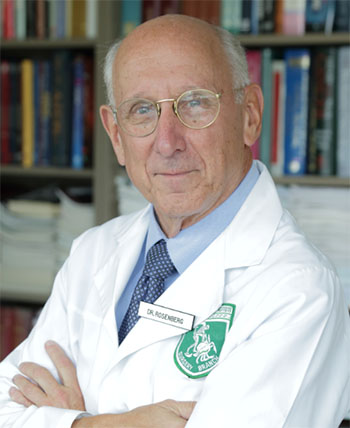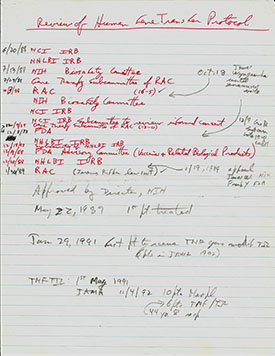Gene Therapy Turns 30 Years Old
An NIH First That Almost Didn’t Happen
When Steven Rosenberg reviewed a draft email-blast message advertising his upcoming keynote address at a May 9, 2019, meeting at the University of Pennsylvania, he was struck by the final paragraph:
“This symposium comes at a historic time. Thirty years ago this May, Dr. Rosenberg and colleagues shepherded in the era of gene therapy when they removed, genetically altered, and returned cells to a patient with malignant melanoma.”

CREDIT: NCI
Steven Rosenberg
“This is not the kind of thing I keep track of, these historic events,” said Rosenberg, who as long-serving chief of the National Cancer Institute (NCI) Surgery Branch was the first to insert foreign genes into a human. “I’m too busy keeping track of today’s events.”
Nevertheless, he pulled out a set of handwritten notes in faded pencil and ink, circa 1990, listing the dates of the unprecedented 16 reviews needed to perform the world’s first gene-therapy experiment on a human. Next came a copy of the 1990 paper in the New England Journal of Medicine (N Engl J Med 323:570–578, 1990) describing the 1989 experiments, along with Rosenberg’s own printed list of historic NIH “firsts” around this period.
Then he rattled off names of colleagues and descriptions of patient volunteers as if the historic events transpired yesterday. Rosenberg’s surprise over the 30th anniversary perhaps was more of a tempus fugit feeling. Time flies when you’re pioneering the development of effective immunotherapies and gene therapies for patients with advanced cancers.
As far as classic clinical studies go, the set of gene-therapy experiments in 1989 was akin to the NIH face that launched a thousand research ships. Gene therapy is now performed worldwide, with several gene-therapy drugs approved by the FDA, including one that Rosenberg helped develop (axicabtagene ciloleucel, trade name Yescarta, for the treatment of adult patients with relapsed or treatment-resistant large B-cell lymphoma).

Thirty years ago, Rosenberg and his team were building on the pathbreaking experimentation by French Anderson (National Heart, Lung, and Blood Institute, NHLBI), Michael Blaese (National Human Genome Research Institute), and others at the NIH who in 1985 used a retrovirus to carry a correct human gene for adenosine deaminase (ADA) into patient cells in a tissue culture.
In 1988, NIH researchers switched from bone marrow to white blood cells as the cell of choice to “infect” with the retrovirus, which dramatically increased the number of correct genes taken up by the cells in animal experiments. This result set the stage for Rosenberg’s group, who in 1988 were the first to use non–genetically modified tumor-infiltrating lymphocytes (TIL) cells to successfully mediate tumor regression.
On May 22, 1989, Rosenberg and his team attempted a retroviral-mediated gene transduction to introduce the gene coding for resistance to neomycin into human TIL cells before their infusion into patients; the goal was to help determine the traffic of the infused cells in the body. The results of this proof-of-concept experiment with marked TIL cells, first performed on a 52-year-old truck driver from Indiana, demonstrated that the engineered virus can be used safely in humans and also elucidated the prolonged survival of the transferred cells in the patient.
To the degree that they fulfilled their goal, the initial experiments on the truck driver and four other patients were a success, with no signs of toxicity or ill effects of the procedure, although all the patients ultimately died of their cancer.
The preceding year, however, had been filled with trouble and angst. In mid-1988, Rosenberg sought permission from the NCI and NHLBI institutional review boards to conduct his experiment. It was so novel that more and more reviews were needed. On October 3, 1988, the Recombinant DNA Advisory Committee (RAC) approved the Rosenberg-led experiment by a margin of 16 to 5. That approval should have been the green light.
However, given the controversy of gene therapy—with some members of the public opposed to scientists “playing God” and tinkering with the human genome—the NIH Director at the time, James Wyngaarden, mandated that the experiment could only move forward with a unanimous vote from the RAC. Perhaps miraculously, Rosenberg got just that—a 13 to 0 RAC vote—on December 9, 1988. And that unanimous approval again should have been the green light.
However, upon Wyngaarden’s approval, American economic and social theorist Jeremy Rifkin, representing the Foundation on Economic Trends, filed suit against the NIH. Rifkin, well known as an activist against certain biotechnology trends, argued that the RAC approval was not at a public meeting and violated NIH guidelines. This matter took several more months to resolve.
To the dismay of Rosenberg, the son of Jewish immigrants from Poland, news organizations announced the final approval of his gene-therapy experiment in the context of Adolf Hitler, Nazi Germany, and the eugenics movement. All Rosenberg and his colleagues wanted to do, of course, was to save lives, not change the course of human evolution.
With the success of the initial gene-therapy experiments, Anderson, working with Blaese and Rosenberg at the NIH, stepped up the game in 1990 with the therapeutic use of a virus to deliver the correct gene to two girls, ages 4 and 9 years old, with ADA deficiency. The results also were successful, albeit limited.
Progress in gene therapy has since exploded, with more than 2,000 clinical trials worldwide, according to the Gene Therapy Clinical Trials Worldwide Database. These trials include dozens of clinical trials at the NIH testing immunotherapy for cancers and other cell-based therapies for diseases such as sickle cell. To facilitate even more experimentation, the NCI has invested in a 6,000-square-foot facility with sterile cell-processing units to create naturally occurring and genetically modified lymphocytes for patient therapy. This facility is under construction between Buildings 10 and 30 on the NIH Bethesda, Maryland, campus.
The impact will be huge, and it all started right here 30 years ago.
To read the profile of Steven Rosenberg that appeared in the January-February 2018 issue of the NIH Catalyst, go to https://irp.nih.gov/catalyst/v26i1/steven-a-rosenberg-md-phd.
This page was last updated on Monday, April 4, 2022
